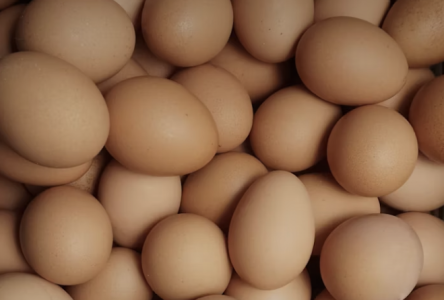You’ve been storing eggs all wrong—here’s what MIT scientists just discovered (and it might change packaging forever)
- Replies 0
Think you know the best way to keep your eggs safe? Think again.
A surprising new study is challenging everything you thought you knew about that humble carton sitting in your fridge—and it may just flip the food industry on its head.
In a breakthrough that’s already sparking debate across kitchens and grocery aisles alike, researchers at MIT have revealed that the standard upright egg packaging we all rely on might be the worst way to protect these fragile ovals.
Their findings suggest that a simple shift in orientation—laying eggs flat on their sides—could significantly reduce the chances of cracking. And yes, it’s all backed by cold, hard physics.

The verdict? Eggs dropped on their equator—that is, lying flat on their sides—were dramatically less likely to crack than those dropped on their ends.
Also read: Buried secrets? The CIA’s unexpected hunt for a legendary relic—here’s what they found.
Specifically, less than 10% of the sideways-dropped eggs cracked from an 8mm height. In contrast, more than half of the vertically dropped eggs—whether on the sharp or blunt end—didn’t survive the fall.
Compression tests further revealed that sideways-oriented eggs were also more flexible, compressing more before finally cracking.
Researchers believe this is because the middle of the egg can absorb more energy, acting like a shock-absorbing cushion.
But these findings indicate it may be time for packaging designers to rethink the carton entirely.
“We contest the commonly held belief that an egg is strongest when dropped vertically,” the researchers wrote. “These results suggest an egg dropped on its equator can likely sustain greater drop heights without cracking.”
Also read: Think your food’s safe after falling? The truth about the five-second rule might gross you out
This isn’t just an idle observation. For grocery stores, food producers, and delivery services, cracking fewer eggs means cutting costs, reducing waste, and improving shelf stability—all by just shifting the way the egg lies in its carton.
While many cooks give the egg a whack around its middle, the data suggests the opposite: if you want a clean break, go for the top or bottom. That’s where the shell is weakest.
So the next time you're baking or making breakfast, aim for the pole—not the side.
Understanding how and where they fail could inform everything from sports equipment and helmets to drug-delivery capsules.
“Insights on the mechanical failure of these structures may thus enable progress in a myriad of applications ranging from the design of protective equipment to drug delivery,” the team said.
Read next: Save money and avoid bird flu: Uncover the top egg substitutes you need to know now!

Would you buy eggs that lie flat in new packaging? Should grocery stores rethink decades of shelf design? And will you start tapping your eggs on the end from now on? Let us know in the comments how you feel about flipping the script on one of your kitchen’s most fragile staples.
A surprising new study is challenging everything you thought you knew about that humble carton sitting in your fridge—and it may just flip the food industry on its head.
In a breakthrough that’s already sparking debate across kitchens and grocery aisles alike, researchers at MIT have revealed that the standard upright egg packaging we all rely on might be the worst way to protect these fragile ovals.
Their findings suggest that a simple shift in orientation—laying eggs flat on their sides—could significantly reduce the chances of cracking. And yes, it’s all backed by cold, hard physics.

Laying eggs flat on their sides could significantly reduce the chances of cracking. Raiyan Zakaria / Unsplash
Eggs Are Tougher Than They Look—But Only Sideways
In a study published this week in Communications Physics, MIT scientists dropped a total of 180 raw chicken eggs from various small heights—testing whether horizontal or vertical orientations fared better under pressure.The verdict? Eggs dropped on their equator—that is, lying flat on their sides—were dramatically less likely to crack than those dropped on their ends.
Also read: Buried secrets? The CIA’s unexpected hunt for a legendary relic—here’s what they found.
Specifically, less than 10% of the sideways-dropped eggs cracked from an 8mm height. In contrast, more than half of the vertically dropped eggs—whether on the sharp or blunt end—didn’t survive the fall.
Compression tests further revealed that sideways-oriented eggs were also more flexible, compressing more before finally cracking.
Researchers believe this is because the middle of the egg can absorb more energy, acting like a shock-absorbing cushion.
So… Why Are Eggs Still Sold Upright?
That’s the question researchers are now asking. Traditional egg cartons cradle each egg point-up or point-down, offering symmetrical rows for aesthetics and stackability.But these findings indicate it may be time for packaging designers to rethink the carton entirely.
“We contest the commonly held belief that an egg is strongest when dropped vertically,” the researchers wrote. “These results suggest an egg dropped on its equator can likely sustain greater drop heights without cracking.”
Also read: Think your food’s safe after falling? The truth about the five-second rule might gross you out
This isn’t just an idle observation. For grocery stores, food producers, and delivery services, cracking fewer eggs means cutting costs, reducing waste, and improving shelf stability—all by just shifting the way the egg lies in its carton.
Cracking Eggs the Wrong Way, Too?
The MIT study didn’t stop at packaging—it also challenges how we crack eggs.While many cooks give the egg a whack around its middle, the data suggests the opposite: if you want a clean break, go for the top or bottom. That’s where the shell is weakest.
So the next time you're baking or making breakfast, aim for the pole—not the side.
Beyond the Fridge: Big Implications in Science and Design
This isn’t just about eggs. The study also hints at broader lessons for nature and engineering. Eggshells, like turtle shells or viral membranes, protect soft-bodied structures with elegant strength.Understanding how and where they fail could inform everything from sports equipment and helmets to drug-delivery capsules.
“Insights on the mechanical failure of these structures may thus enable progress in a myriad of applications ranging from the design of protective equipment to drug delivery,” the team said.
Read next: Save money and avoid bird flu: Uncover the top egg substitutes you need to know now!
Key Takeaways
- New MIT research shows eggs are far less likely to crack when dropped on their side (equator) versus upright.
- Less than 10% of eggs dropped sideways from 8mm cracked, compared to over 50% of vertically dropped eggs.
- Study suggests egg cartons should be redesigned to protect eggs more effectively by laying them flat.
- Findings also challenge how most people crack eggs—scientists say tapping the top or bottom is more effective than cracking around the middle.






